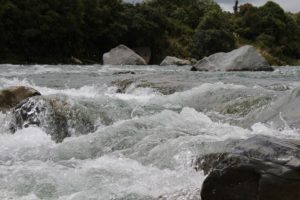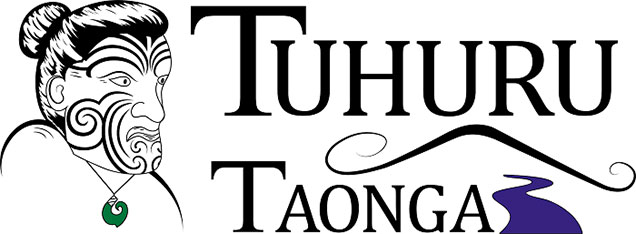Arahura Te Awa, Pounamu Te Taonga
The Arahura river is the life force of the Ngāti Waewae people. It is where their most prized resource pounamu is found. Pounamu occurs all over the West Coast, but it is the stone found on the Arahura river and its tributaries that is most precious to them. Ngāti Waewae is a (hapū) sub-tribe of Ngāi Tahu, the largest tribe of the New Zealand’s South Island. Ngāti Waewae are considered kaitiaki (guardians) of pounamu.
Poutini & Waitaiki
Poutini was a taniwha or guardian of pounamu. He feared another taniwha named Whaitipu, the guardian of Hinehoaka, who was the goddess of sandstone. Traditionally, sandstone knives were used to cut pounamu.
Once, Poutini was being pursued in the sea by Whaitipu and took refuge in a bay at Tūhua (Mayor Island, in the Bay of Plenty). There, Poutini observed a beautiful woman named Waitaiki coming down to the water to bathe. Enthralled by her beauty, he captured her and swam towards the mainland.
When Tamaahua, Waitaiki’s husband, discovered that his wife was missing, he used karakia (incantations) and divination with a small, dart-like spear to find her. He threw the spear, which pointed towards the location of Poutini.
Tamaahua chased Poutini through the North Island and down to the South Island, eventually finding him at the Arahura River. Fearing capture, but refusing to give Waitaiki up, Poutini turned her into his own essence – pounamu – and laid her in the river bed at the junction of the Arahura and a nearby stream. That stream became known as Waitaiki, and ever since it has been a significant source of pounamu, as is the Arahura River.
Tamaahua did not see Poutini, who slipped past him, and on finding his wife turned to inanga (a type of pounamu) he grieved for her and then returned home.
Poutini, having eluded Tamaahua, continued down the river to the coast.
Since that time, he has swum the West Coast acting as a guardian spirit of the land and pounamu. From this comes the name Te Tai Poutini (the tides of Poutini) for the West Coast.
Tūhuru & Papakura
Tūhuru Kokare was born in the late part of the eighteenth century. He spent his early life with his parents, Te Ruahuanui and Titohi, at Kaikainui, the pā of his grandfather Waewae. Waewae was a son of Ngāi Tahu chief Tūrakautahi.
Tūhuru was a chief of Ngāti Waewae, a hapū of Ngāi Tahu. He reached adulthood during a turbulent period in the Māori history of the South Island. In the eighteenth century Ngāi Tahu from Canterbury went to the source of greenstone in the Arahura and Māwhera (Grey) regions of the West Coast, and fought with the local people, Ngāti Wairangi. They destroyed Ngāti Wairangi’s pā at Māwhera (Greymouth) and returned east. Later, several hapū of Ngāi Tahu combined to defeat Ngāti Wairangi.
Tūhuru was a fierce and powerful warrior chief, of huge stature said to be 7ft tall. He and his hapū were involved in the defeat of Ngāti Wairangi at Kōtuku-whakaoho (Lake Brunner) about the turn of the nineteenth century. From here they commenced the conquest of the West Coast. The campaign started in the Karamea district. Tūhuru systematically worked his way down the coast, defeating all before him, as far as Makawhio (Jacobs River). Legendary Battles were fought at Karamea, Whanganui Inlet, Kawatiri, Māwhera, Taramakau, Arahura, Hokitika, Okarito and Makawhio.
The final defeat of Ngāti Wairangi took place in the Paparoa Range, after which a meeting of Tūhuru and his party was held at Rūnanga. They discussed whether to return to Kaikainui or stay on the West Coast. No decision was reached. The party crossed the Māwhera River to Omotumotu (Omoto), where a decision was made to stay.
Tūhuru and his people established a new pā at Māwhera and settled there. They were known as Poutini Ngāi Tahu, the Ngāi Tahu people of the West Coast. Tūhuru was now faced with the defence of his territory and was successful against Ngāti Tumatakokiri from the northern part of the South Island, who came to take greenstone by force rather than trade. However, a flourishing trade in greenstone through Kaiapoi developed during this period.
Tūhuru and his wife, Papakura, had six children: Hinekino, Tarapuhi Te Kaukihi, Wereta Tainui, Nihorere, Tawhao and Te Hiakai. Tūhuru died around the 1850’s, his body was placed in a burial cave above the Māwhera pā. His son, Tarapuhi, succeeded him as leader of Ngāti Waewae. When Tarapuhi died in 1864 his brother, Wereta Tainui, became chief.
